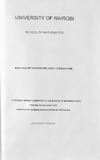| dc.description.abstract | It is generally agreed that amongst the objectives of a punitive or correctional system is the prevention of the re-occurrence of criminal behavior on the part of those who have deviated from the socially accepted and legally prescribed rules of conduct. The aim of many programs of treatment of criminal offenders is the preventiof of recidivism, and the choice of any treatment plan is based upon the conviction that of what is known about the characteristics of an offender, a particular method of treatment will best realize the objectives of the correctional system. Offenders are placed on probation, incarcerated, released on parole, etc., when the accumulated evidence suggests that they possess that pattern of attributes which tends to insure the favorable response of offenders not recidivating. The accuracy of this choices determines not only the effectiveness of any treatment program in achieving the desired results, but also the manner in which the community is safeguarded against predatory individuals.
The procedures involved in making such decisions, the kind of information utilized in arriving at decisions are of the utmost importance in the administration of criminal justice. The relationship between various factors and demographic characteristics of released offenders and recidivism is investigated in a sample of 402 adult male offenders in this study. Age, work experiences, marital status, as well as the education level contributed Significantly to the relapse to crime. A unit increase in age reduces the risk of relapse by 4%, released convicts from slum dwellings are three times more likely to recidivate than their counterparts from all other dwellings, those with previous work experience have 60% less chance of recidivating than those without, released felons that were married before arrest have 50% less chances of recidivating than their un-married counterparts and a unit increase in education level reduces the risk of recidivating by 44%. However, those released on parole did not show any differences with those released after serving their entire sentences. Interactions between some of this variables also showed significance in predicting recidivistic behaviour. | en_US |

